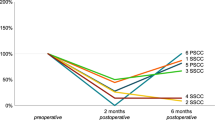Abstract
Development of the video head impulse test (vHIT) assessing all three semicircular canals in both labyrinths has uncovered the existence of new vestibular failure patterns and made bilateral posterior canal dysfunction detection possible. We conducted a retrospective analysis of 41 patients with bilateral posterior semicircular canal failure and compared results to 37 controls, with normal posterior semicircular canal function. Mean calculated gain showed significant difference between patients and controls in right [0.54 (SD 0.016)] and left [0.57 (SD 0.014)] posterior semicircular canals. There was a peak in prevalence between 71 and 80 years. Presentation was chronic in 78% of patients, and gait instability was the most common complaint. Sixty eight percent of cases were classified as idiopathic. Significant difference between groups was seen regarding the presence of Meniere's disease, presbycusis, and positional down-beat nystagmus (posDBN). This new vHIT pattern is most often seen in elderly patients, mainly of idiopathic etiology and presents together with sensorineural hearing loss and posDBN. Our findings suggest idiopathic cases may well contribute to the so-called “presbyastasis”.





Similar content being viewed by others
References
MacDougall HG, Weber KP, McGarvie LA, Halmagyi GM, Curthoys IS (2009) The video head impulse test. Diagnostic accuracy in peripheral vestibulopathy. Neurology 73:1134–1141
MacDougall HG, McGarvie LA, Halmagyi MG, Curthoys IS, Weber KP (2013) Application of the video head impulse test to detect vertical semicircular canal dysfunction. Otol Neurotol 34:974–979
Guerra Jimenez G, Perez FN (2016) Reduction in posterior semicircular canal gain by age in video head impulse testing. Observational study. Acta Otorrinolaringol Esp 67(1):15–22
Tarnutzer AA, Bockisch CJ, Buffone E, Weber KP (2017) Association of posterior semicircular canal hypofunction on video-head-impulse testing with other vestibulo-cochlear deficits. Clin Neurophysiol 128:1532–1541
Tarnutzer AA, Bockisch CJ, Buffone E, Weiler S, Bachmann LM, Weber PK (2016) Disease-specific sparing of the anterior semicircular canals in bilateral vestibulopathy. Clin Neurophysiol 127:2791–2801
Sousa RF, Levy J, Campos J, Louis L (2019) Bilateral inferior vestibular nerve lesion a late neurotoxic effect of liposoluble myelographic contrast agent. Clin Neuroradiol 29(1):163–165
Bisdorff AR, Staab JP, Newman-Toker DE (2015) Overview of the international classification of vestibular disorders. Neurol Clin 33:541–550
Seonhye K, Oh Y-M, Koo J-W, Kim JS (2011) Bilateral vestibulopathy: clinical characteristics and diagnostic criteria. Otol Neurotol 32:812–817
Van de Berg R, Van Tilburg M, Kingma H (2015) Bilateral vestibular hypofunction: challenges in establishing the diagnosis in adults. ORL 77:197–218
Rosenhall U, Rubin W (1975) Degenerative changes in the human vestibular sensory epithelia. Acta Otolaryngol 79:67–80
Rosenhall U (1973) Degenerative patterns in the aging of human vestibular neuro-epithelia. Acta Otolaryngol 76:208–220
Mathenson AJ, Dralington CL, Smith PF (1999) Dizziness in the elderly and age-related degeneration of the vestibular system. NZ J Psychol 28(1):10–16
Li C, Layman AJ, Geary R et al (2015) Epidemiology of vestibulo-ocular reflex function: data from the baltimore longitudinal study of aging. Otol Neurotol 36(2):267–272
McGarvie LA, MacDougall HG, Halmagyi GM, Burgess AM, Weber KP, Curthoys IS (2015) The video head impulse test (vHIT) of semicircular canal function—age-dependent normative values of VOR gain in healthy subjects. Front Neurol 6:154
Matino-Soler E, Esteller-More E, Martin-Sanchez JC, Martinez-Sanchez JM, Perez-Fernandez N (2015) Normative data on angular vestibulo-ocular responses in the yaw axis measured using the video head impulse test. Otol Neurotol 36:466–471
Mallinson AI, Longridge NS (2004) Caloric response does not decline with age. J Ves Res 14:393–396
Fernández L, Breinbauer HA, Hinckley DP (2015) Vertigo and dizziness in the elderly. Front Neurol 6:144
Walther LE, Westhofen M (2007) Presbyvertigo-aging of otoconia and vestibular sensory cells. J Vestib Res 17(2–3):89–92
Anson E, Jeka J (2016) Perspectives on aging vestibular function. Front Neurol 6:269
Wagner JN, Glaser M, Brandt T, Strupp M (2008) Downbeat nystagmus: aetiology and comorbidity in 117 patients. J Neurol Neurosurg Psychiatry 79(6):672–677
Choi JY, Kim JH, Kim HJ, Glasauer S, Kim JS (2015) Central paroxysmal positional nystagmus. Characteristics and possible mechanisms. Neurology 84(22):2238–2246
Author information
Authors and Affiliations
Corresponding author
Ethics declarations
Conflicts of interest
The authors report no conflicts of interest. The authors alone are responsible for the content and writing of paper. No sponsorships or competing interests have been disclosed for this article.
Ethical standard
The manuscript does not contain clinical studies or patient data.
Rights and permissions
About this article
Cite this article
Lerchundi, F., Laffue, A.H., Olivier, M. et al. Bilateral posterior semicircular canal dysfunction: a new finding with video head impulse test. J Neurol 267, 2347–2352 (2020). https://doi.org/10.1007/s00415-020-09793-5
Received:
Revised:
Accepted:
Published:
Issue Date:
DOI: https://doi.org/10.1007/s00415-020-09793-5




